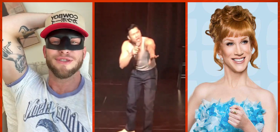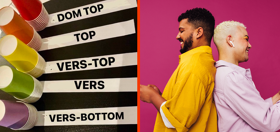
The language of sexual and gender identity has dramatically changed and expanded over time, reflecting how these are extremely personal journeys unique to the person experiencing them. Because of this, many “micro-identities” and niche sexualities have emerged and made their way into mainstream discourse.
One such micro-identity is “heteroflexible”, a hotly contested term that has its fair share of advocates and critics. But what is “heteroflexible”, and does it apply to you? Keep reading to find out!
RELATED: All About the Trixic Pride Flag and Being Trixic
What Does Heteroflexible Mean?
Heteroflexibility refers to a type of sexual orientation where the person primarily experiences romantic and/or sexual attraction to persons who identify as the opposite sex but may occasionally experience romantic and/or sexual attraction to persons of the same sex.
How about we take this to the next level?
Our newsletter is like a refreshing cocktail (or mocktail) of LGBTQ+ entertainment and pop culture, served up with a side of eye-candy.
Heteroflexible’s definition can generally be summed up as “mostly straight” or, as sociologist Hector Carillo put it, “straight with a pinch of bi.”
The word “heteroflexible” has a counterpart in the term “homoflexible”, which describes a person who primarily experiences romantic and/or sexual attraction to individuals of the same sex but may occasionally experience romantic and/or sexual attraction to persons of the opposite sex.
What Is The Origin Of The Word ‘Heteroflexible’?
There is no known definite origin for the terms “heteroflexible” or “heteroflexibility”. However, the word “heteroflexible” is recorded to have appeared in media as far back as the ‘90s. In 1997, the LGBTQ humor glossary When Drag is Not a Car Race defined “heteroflexibility” as “bisexual, or at least open to sexual experimentation.”
The word gained some traction at the beginning of the millennium. In 2000, Salon published an article titled “Heteroflexible” and written by Laurie Essig, then a Yale professor of sociology.
Essig defined heteroflexibility as when someone “has or intends to have a primarily heterosexual lifestyle, with a primary sexual and attachment to someone of the opposite sex, but that person remains open to sexual encounters and even relationships with persons of the same sex.”
In 2002, The Buffalo News named “heteroflexible” the “hot term being bandied about on campus” and giving heteroflexible the meaning, “the condition of being not fully bisexual, but open to adventure.”

What’s The Difference Between Heteroflexibility And Bisexuality?
As can be seen in the definition from When Drag Is Not a Car Race, the term “heteroflexibility” may be used synonymously with bisexuality. Or, at the very least, there is overlap between the terms.
“Bisexuality” is defined in the Oxford dictionary as “the quality or characteristic of being sexually attracted not exclusively to people of one particular gender.” From this definition, heteroflexibility appears to fall under bisexuality.
Bisexuality is a spectrum, and a bisexual person may have a stronger leaning toward one of the sexes they can be attracted to. People can also identify as both bisexual and heteroflexible.
However, in the Salon article “Heteroflexible”, Essig called heteroflexibility “a rejection of bisexuality since the inevitable question that comes up in bisexuality is one of preference, and the preference of the heteroflexible is quite clear.”
At this point, there is no singular, universally accepted perspective on the differences or similarities between heteroflexibility and bisexuality.
There is also overlap between heteroflexibility and other terms such as pansexuality (being attracted to all genders, without noticing gender), omnisexuality (being attracted to all genders, with notice to gender), and polysexuality (being attracted to multiple genders; both omnisexuality and pansexuality can be considered subsets of polysexuality).

Controversy Around The Use Of “Heteroflexible”
The word “heteroflexible” has been the subject of criticism. While labels can be handy tools for helping a person to understand their own identity and to find people similar to them, they can also have negative connotations.
In the 2009 paper “The Re-Making of Sexual Kinds: Queer Subjects and the Limits of Representation”, Lisa Blackman noted that the term “heteroflexible” normalizes heterosexuality rather than homosexuality. While emphasizing the heterosexual aspect, the flexibility is only a “temporary interruption” or a “break from the routine” of heterosexuality.
Writer Charlie Williams also wrote an article in Affinity magazine, calling the term “really just a fancy word for bi-erasure”.
Williams went on to say, “It states that being bi is something bad and that labeling yourself with a completely different term will magically erase the fact that you are bisexual. There is absolutely nothing wrong with not wanting to label your love, or being confused in general. The problem is when your labels invalidate my sexuality, as well as other bisexuals.”
Similarly, writer Kravitz M. in An Injustice! webzine spoke out about some bisexuals being subjected to so many biphobic remarks that they considered switching labels, which includes the heteroflexible label: “Sometimes, the issue isn’t as simple as a mere preference for another name. Bisexual identity is discouraged by people of all other identities.”

Final Thoughts On Heteroflexibility
The term “heteroflexible” may still be contentious in the LGBTQ+ community. On the one hand, some people think it devalues the discrimination and challenges that queer people face. On the other, it acknowledges that attraction to genders other than the opposite sex can exist on a spectrum – just like other sexualities do.
At the end of the day, the most important thing is that you feel comfortable with the label or orientation you’re claiming. Remember: these labels aren’t prescriptive, but descriptive. If “heteroflexible” feels like the right identifier for where you are at in your journey, feel free to use it!


















skeldare
Heteroflexibility isn’t a real thing. It’s for people who are too afraid to tell people they’re bisexual.
Bosch
Amen.
jt1990
Are you a science denier also? How dare you question tHe ExPeRtS, who say this is a real thing!
mz.sam
No f***in’ s**t, Sherlock.
Den
“jt1990
Are you a science denier also? How dare you question tHe ExPeRtS, who say this is a real thing!”
This is an opinion piece, nothing in the slightest empirical about it. All your comment demonstrates is that right wingers have no idea what science is. And nobody is surprised by that at all.
nowliveit
Well this may be true but the words don’t capture the unique situation I have. My closest straight friend ever. I am the only man he wants to have sex with. He doesn’t find me or any man handsome. We are attracted to each other only because we resonate with each other’s Inner Light. We may 8 years ago and instantly connected at our soul level.
What word could cover that?
HeteroLightFlexible? HeteroSoulDesire?
Hmm
Bosch
Bisexual. Being loyal to one person doesn’t negate sexuality, and it certainly doesn’t negate homosexual sex.
Hetero means “different”, but you and him are not of a different sex. Of course, there is an urge in the zeitgeist to label oneself as heterosexual as believably possible. That’s exactly what the word “heteroflexible” is for: advertising you like dick but #nohomo.
I believe you devalue the love he has for you if you try to straight-wash it.
Diplomat
Sounds like soul sex to me. That’s very rare and quite special.
nowliveit
Amen Diplomat
GlobeTrotter
I’ve deflowered so many so-called “straight” guys, that I stopped counting years ago. In my experience most straight men are at least curious, and if you simply be a friend instead of chasing them like a piece of meat, they’ll just open up to you (no pun intended).
Maybe it’s just me, but I find the guys at gay bars to be arrogant, bitchy and full of themselves. That’s why I stopped going to gay bars in 2002. Since then I only go out to “normal” bars/clubs and take home more guys than when I used to go to gay bars.
I’ve gotten my hands into the pants of macho dudes, a few male models (!), body-building dudes, even a few right-wing bigots. The more homophobic they are, the easier the fold. It’s like taking candy from a baby…
bachy
Sign me up for the first edition of your autobiography!
Fahd
Not to take away from the editors’ hard work putting this wiki-article together, but how is this classifying, labeling, elaborating of taxonomies of sexuality helpful? I guess if you’ve got a psych exam coming up, then this could be the thing, but “book learning” has its limits. After all, there are so many individual differences among people.
Bosch
Even on a psych exam, the subject here would be the disconnect between sexual orientation and sexual identity; undoubtedly in a section about Compulsory Heterosexuality.
monty clift
Looks like it was written by a Tumblr tween.
johncp56
Enough Bi men are hot even if they swing more to same sex, OMG all the terms, i,m old school Gay man, lol so am I gayflexible as I,m attracted to my FTM men also
MrMichaelJ
As far as I can tell the vast vast majority of men aren’t 100% straight
sasquatchmike
I totally agree with you! I wasn’t but I claimed straightness because of the famous ‘societal’ pressure. Bisexual spectrum? Are we autistic? I am older and I have learned that most people who want sex aren’t particular about the “sexual identity” of their potential partner, it’s much more about mutual desire for a person. Not a gay guy or a straight woman but a person whom you can connect with.
Joshua333
This is just people on the bisexual spectrum…
bachy
In classical ancient cultures, wealthy married men frequently had slaves who provided sexual pleasures outside the standard, marital formula. I contend that given enough wealth (or freedom from pervasive Puritanical restrictions), most men are probably what can be described as heteroflexible.
michel_banen
So that’s a lot of words to basically say it’s bi-sexuality with a preference for the opposite sex.
Toofie
That was a lot to describe bisexuality…
Den
As if the idiotic “neptunic” article (with its list of too many other fake sexual orientations) was not bad enough. Let’s take a microtome to what is actually fairly simple and basic sexuality and slice it down until there are as many orientations as there are people! Just as you are either male or female (and I include cis and trans in there), you are either hetero, homo or bi. That is it, there is no more. Your individual preferences for where someone stands on the culturally created masculine/feminine spectrum is just that: YOUR INDIVIDUAL PREFERENCE AND PERSONAL STYLE. We don’t need a million names, a million definitions, a million flags. If you are a trans woman who likes masculine women, YOU ARE A LESBIAN! if you are a “queer” man who likes femme cis men and masculine trans women, YOU’RE BISEXUAL. If you have to have an intellectual connection with whoever you sleep with, THAT IS NOT SOME SPECIAL SEXUAL ORIENTATION, IT IS A PERSONAL PREFERENCE…A CHOICE LAID IN TOP OF YOUR INTRINSIC SEXUALITY.
All this other crap is childish, based on nothing empirical and in the worst case gives the regressive minded yet another reason to think we are simply weirdos who have made “sinful lifestyle choices”! Get over yourselves children, you are hurting the cause of equal protection under the law for all by being dumb!